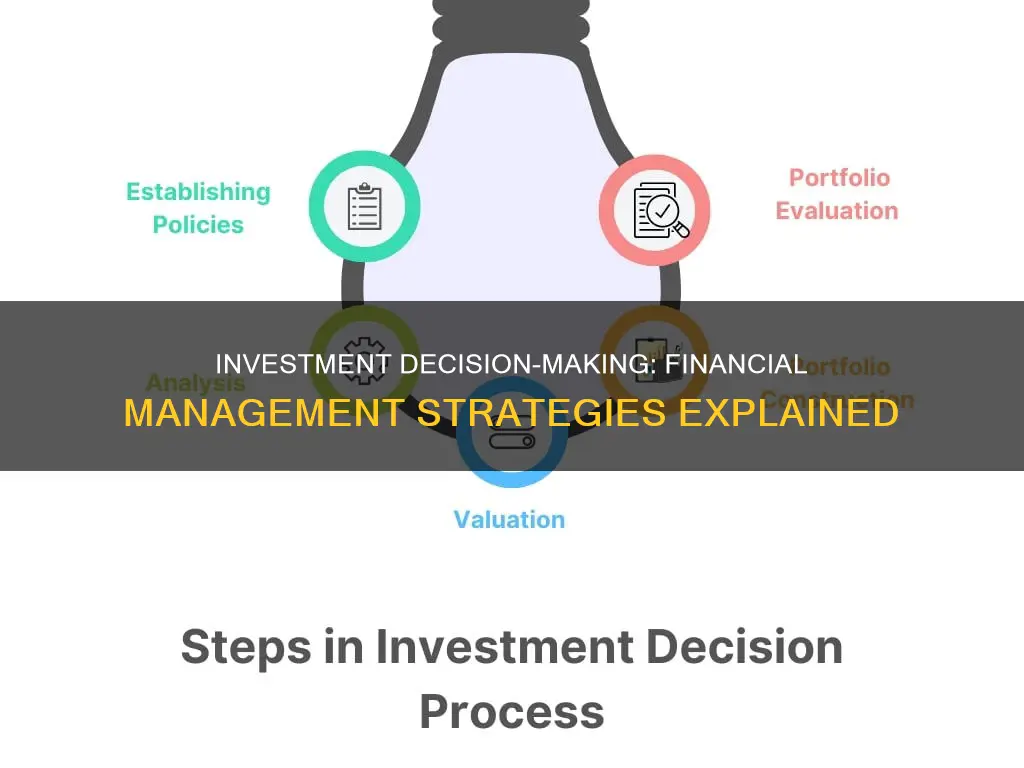
Investment decisions are a crucial aspect of financial management, involving the allocation of a firm's resources to maximise returns for investors. These decisions can be long-term or short-term, with long-term investment decisions, also known as capital budgeting decisions, requiring substantial investments in fixed assets such as new machinery or expansion. Short-term investment decisions, known as working capital decisions, focus on managing current assets and liabilities, including cash, inventory, and receivables, to ensure day-to-day operations run smoothly. Both types of investment decisions are essential for a company's survival and long-term success, and they must be carefully evaluated and balanced to optimise profitability and liquidity.
| Characteristics | Values |
|---|---|
| Type | Long-term or short-term |
| Investment type | Own business or outside business |
| Investment area | Expansion, diversification, productivity improvement, product improvement, research and development, acquisition of assets, mergers and acquisitions |
| Investment criteria | Cash flow, rate of return, investment criteria |
| Risk | Risk-return trade-off |
| Liquidity | Management of current assets and liabilities |
| Profitability | Affects profitability |
What You'll Learn

Long-term investment decisions
When making long-term investment decisions, companies should consider the following:
- Cash flow of the project: Analyzing the expected net cash flows over the investment's life and ensuring that the investment is worthwhile.
- Rate of return: Selecting projects with a higher rate of return, provided the risk level is the same.
- Investment criteria: Evaluating each investment opportunity using capital budgeting techniques, including calculations of the investment amount, interest rate, cash flows, and rate of return.
Long-term investments can provide meaningful wealth creation and are often less time-consuming and have lower transaction fees. They can contribute to a company's financial health and support business expansion. Examples of long-term investments include real estate, stocks, bonds, and other companies' shares.
Devising an Investment Portfolio: Strategies for Success
You may want to see also

Short-term investment decisions
These decisions are important for a business as they can help maintain a sound working capital. Efficient cash management, inventory management and receivables management are essential ingredients of sound working capital management.
For example, while debt is considered the cheapest source of finance, a higher proportion of debt increases the financial risk for the company. Short-term investment decisions are crucial as they can affect a company's survival and ability to achieve its objectives.
Unit Investment Trusts: Are They Truly Managed?
You may want to see also

Capital budgeting decisions
The primary goal of capital budgeting is to identify projects or investments that will produce cash flows exceeding the cost of the project for a company. Companies use capital budgeting techniques to evaluate potential major projects or investments and determine which will yield the best return over an applicable period. This process involves analyzing a project's cash inflows and outflows to determine whether the expected return meets a set benchmark.
There are several methods used in capital budgeting, including discounted cash flow analysis, payback analysis, and throughput analysis. Discounted cash flow analysis considers the initial cash outflow, the mix of cash inflows in the form of revenue, and future outflows such as maintenance costs. These cash flows are discounted to the present date to calculate the net present value (NPV), which is a measure of the project's profitability.
Payback analysis is a simpler form of capital budgeting that calculates how long it will take to recoup the costs of an investment. This method is widely used due to its speed and ability to provide a quick estimate of a project's value. However, it does not account for opportunity costs and tends to ignore cash flows near the end of a project's life.
Throughput analysis is the most complex but accurate method, treating the entire company as a single profit-generating system. It assumes that maximizing throughput passing through a bottleneck operation will maximize profits.
When making capital budgeting decisions, companies must consider the long-term goals of the business, identify potential investment proposals, estimate and analyze relevant cash flows, and determine the financial feasibility of each investment proposal. Ultimately, the company chooses the projects to implement and monitors their performance against capital budgeting projections, making adjustments as needed.
Overall, capital budgeting is a critical tool for companies to make informed decisions about allocating their capital to new projects or investments. By evaluating the potential returns and risks, companies can maximize shareholder value and make strategic choices that align with their long-term goals.
Asset Management: Understanding Investment Strategies and Benefits
You may want to see also

Investment criteria
Publicly Disclosed Investment Criteria
The most common publicly disclosed investment criteria include the geography, size of the investment or company targeted, and industry. Some buyers also disclose criteria regarding the investment type, which may include management buyouts (MBO), distressed opportunities, or succession situations.
Internal Investment Criteria
Internal investment criteria allow a buyer to quickly determine if the acquisition should be pursued further. Some common internal investment criteria include:
- The strength of the management team
- The estimated IRR on the investment
- Customer diversification
There are also seven investment criteria of capital budgeting:
- Accounting or Average Rate of Return Method
- Pay Back Period
- Discounted Cash Flow Techniques
- Net Present Value Method
- Internal Rate of Return or Yield Method
- Profitability Index (PI) or Benefit Cost Ratio
- Terminal Value (TV) Method
Answering Relationship Manager Questions: Investment Management Edition
You may want to see also

Risk and return
Long-term investment decisions, also known as capital budgeting decisions, involve committing finances for a long period. Examples include investing in a new machine, acquiring a new fixed asset, or opening a new branch. These decisions are crucial as they affect the earning capacity, size of assets, profitability, and competitiveness of a business over the long term.
When making long-term investment decisions, it is essential to consider the risk and return trade-off. Higher risk is typically associated with higher potential returns. For instance, investing in a large plant may generate higher returns than a small plant, but it also carries more risk. Therefore, deciding on the optimal size of an investment requires a careful analysis of the risk and return.
The rate of return is a critical factor in long-term investment decisions. It is important to evaluate the expected returns from each proposal and the associated risks to select the best option. Additionally, the cash flow of the project should be considered, as investments should ideally generate net cash flows that exceed the initial investment.
Short-term investment decisions, also known as working capital decisions, relate to the day-to-day operations of a business and affect its liquidity and profitability. These decisions involve managing current assets and liabilities, such as cash, inventory, and receivables.
Short-term investments also require a balance between risk and return. Maintaining excess liquidity by holding too many current assets can lead to a decline in the rate of return as funds are tied up in idle cash. On the other hand, having insufficient current assets can result in interrupted production and sales, reducing profits. Therefore, a firm should aim for an optimal level of current assets to manage the trade-off between risk and return effectively.
Optimal Financing Mix
The risk and return trade-off is also relevant when determining the optimal financing mix for a company. The financing mix refers to the proportion of debt and equity in a company's capital structure. While debt is typically considered cheaper than equity due to its tax deductibility, it also carries more risk for the company as debt obligations must be met even if the company incurs losses.
To optimise the financing mix, companies aim to balance risk and return. Employing more debt may lead to higher returns but increases risk, while equity provides lower returns due to higher costs but is less risky. Therefore, a proper balance must be struck to maximise shareholder wealth.
In summary, risk and return are inherent components of investment decisions in financial management. Long-term and short-term investment decisions, as well as financing mix decisions, require a careful analysis of the risk and return trade-off to maximise shareholder value and achieve the desired financial objectives.
Savings, Investment, and Productivity: The Interplay for Economic Growth
You may want to see also
Frequently asked questions
An investment decision in financial management involves spending a company's capital on assets that will yield the highest return over a certain period. This decision relates to how a company's funds are invested in different assets.
Investment decisions can be long-term or short-term. Long-term investment decisions are also called capital budgeting decisions and involve committing finance over a long period. Short-term investment decisions are called working capital decisions and affect the day-to-day running of a business.
There are several factors that affect investment decisions, including:
- Cash flow of the project
- Rate of return
- Investment criteria
- Risk and uncertainty
- Profitability
Investment decisions are about how to spend money, while financing decisions are about how to get the money to spend. Financing decisions involve deciding how much capital to raise and what mix of financing to use.







